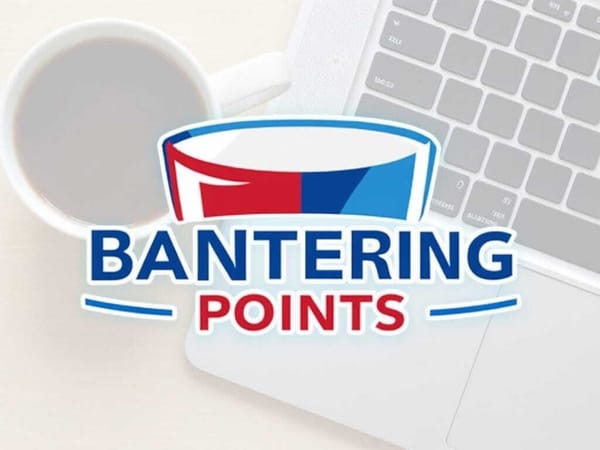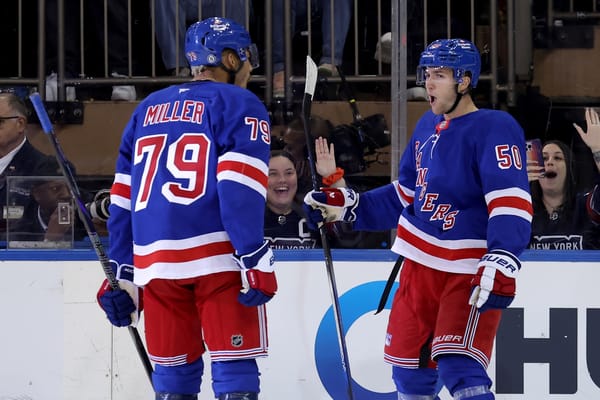New York Rangers Game Score Report: A Recap of Games 1 through 10
The beginning of a series that will run on Blueshirt Banter this season. Spoiler: It involves some math.
One of my favorite people to follow on Twitter is Dom Luszczyszyn, who identifies himself as “a hockey writer and chart boy for The Athletic.” Dom is a lot more than that, and one thing he is known for is Game Score charts.
Game Score was originally a baseball stat used by Bill James, a basketball version was later created by John Hollinger. Dom used that template and applied it to hockey. Like any statistic, it isn’t perfect; but I feel that it’s a metric that has some value.
In his introductory post, Dom explored how Game Score measures performance over consecutive years. He found that top forward from 2011 to 2016 was Sidney Crosby and the top defender was Erik Karlsson – both of which feel accurate.
Here is the formula from that post.
Player Game Score = (0.75 * G) + (0.7 * A1) + (0.55 * A2) + (0.075 * SOG) + (0.05 * BLK) + (0.15 * PD) – (0.15 * PT) + (0.01 * FOW) – (0.01 * FOL) + (0.05 * CF) – (0.05 * CA) + (0.15 * GF) – (0.15* GA)
Goalie Game Score = (-0.75 * GA) + (0.1 * SV)
It should be noted that Corsi and Goal stats are 5v5 adjusted, and all other stats include all situations. Per game represents average Game Score per game which is calculated by taking Total Game Score and dividing it by number of games played.
With that said, every 10 games I am going to post a chart of the Rangers’ Game Score results. Here’s a look at the 2-6-2 New York Rangers.
Great: None
Good: Mika Zibanejad
Thus far, Zibanejad has been the only good player with an average game score of 0.88. It is hard to argue with that, as he has embraced his new role as a No. 1 center with six goals in the first 10 games and a 5v5 Corsi differential of plus-15.
His score would be even higher if his goal differential was neutral or positive, but there’s still a lot to like about how he’s played. So far, he only has an assist, but that is more indicative of the team’s overall inability to finish thus far. The goal production will eventually slow down for Zibanejad, but right now, there’s not much more he should be doing.
Fine: Pavel Buchnevich, J.T. Miller, Kevin Hayes, Kevin Shattenkirk, Mats Zuccarello, Henrik Lundqvist, Chris Kreider, Ryan McDonagh, Marc Staal, David Desharnais, Rick Nash, Jimmy Vesey, Brendan Smith, Brady Skjei, Jesper Fast
There are 15 names on this list, and the first thing you may be asking is, how can a majority of the team be “fine?” In simplest terms, think of the word average instead; these players haven’t been spectacular and they haven’t been an absolute disgrace either. There are different degrees within this category of “fine.” I am not going to touch on every player, that would defeat the purpose of the chart, instead I want to point out a few things I found that were interesting.
1. The Buchnevich Situation
Buchnevich has played only 147 minutes of hockey in all situations. In that time, he’s accumulated five points and 22 shots on goal. At 5v5, he has a positive Corsi differential and a decent goal differential of only minus-1. Additionally, he is tied with Staal in terms of penalty differential with three drawn calls. He is fourth on the team in individual expected goals for per 60 with 0.96, trailing Nash (1.1), Fast (1.13) and Kreider (1.17).
Despite this level of production he has been used sparingly and as a fourth liner in recent games.
Fourth-liner Buchnevich + Shattenkirk creating some offensive chances pic.twitter.com/J65ybrwXJ7
— Shayna (@hayyyshayyy) October 19, 2017
There is a perception that Buchnevich is an incomplete hockey player at this point.
Well what do I mean by this? What I mean is that Jimmy Vesey is in the same boat as Buchnevich in terms of experience, but he’s been afforded more opportunities up in the lineup. Vesey’s stat line features only two points, 20 shots, eight blocks and a minus-15 5v5 Corsi differential. In simplest terms, Vesey is producing less with better opportunities and he isn’t doing a good job keeping puck possession.
2.) J.T. Miller and Kevin Hayes
Miller and Hayes are interlocked in comparison due to the fact that both are forwards who have spent time between center and wing, and both will need new contracts at the conclusion of the season.
Both have played very well this season, and small tweaks could yield even better results. Thus far, Miller’s lone issue has been the possession game and that minus-23 in Corsi differential is what drags his score down. In every other category he has solid results. Contextually, it’s worth nothing that Miller isn’t in a situation where he’s getting killed in the defensive zone, because he’s been used in a primarily offensive role according to this chart by Micah Blake McCurdy.
Hayes on the other hand, is only a negative in terms of faceoff differential, but that isn’t the worst thing in the world. The chart reflects that he has been used in the offensive quadrant, but he is straddling the line of offensive and both in terms of zone starts. Hayes has only taken 17 shots and I feel like he should be shooting the puck more. He’s increased his shot output each year since joining the team (111,133,143) and I think like he could create more chances instead of trying to “Baby Joe Thornton” his way up the ice.
3.) Something Has to Give With The Defense
Ryan McDonagh, Brendan Smith, and Brady Skjei’s numbers aren’t as bad as they have looked at times on the ice.
McDonagh is dinged here by a negative goal differential, negative penalty differential, and a lack of offense thus far. Those aren’t the worst things in the world in all honesty. I am confident that once he has a consistent partner the offensive numbers will get back to a level we have come to expect from him, and that should bring him into the “great” category.
Smith and Skjei have struggled in the puck possession game with a minus-18 and minus-31 Corsi differential, respectively. If those numbers were positive or neutral, this chart tells a different story. But again, I wonder how much of that has been driven by the Helter Skelter changes of defense pairings executed by Alain Vigneault.
4.) Rick Nash Is Snake Bitten
Nash has one goal on the season in over 165 minutes of all situation ice time on 39 shots. He has also had the misfortune of being on the ice for several 5v5 goals scored against, making his differential drop to minus-5. There have been times in which Nash has made a great move only to be foiled by a post or an amazing save, and he really should have about five goals at this point. He’s doing everything required to score a goal, but the puck isn’t going in.
Rick Nash has an unrivaled ability to come as close as humanly possible to scoring goals without actually scoring goals
— Dave Lozo (@davelozo) October 20, 2017
He’s a player who seems due to breakout, because he isn’t going to shoot 2.6 percent all season long.
Poor: Tony DeAngelo, Michael Grabner, Adam Cracknell, Steven Kampfer, Paul Carey, Nick Holden, Filip Chytil, Ondrej Pavelec
If anything, this further reiterates the fact that Kampfer and Holden should not be legitimate options for the Rangers’ defense.
Holden again.... pic.twitter.com/8PfSaQoypq
— Shayna (@hayyyshayyy) October 21, 2017
Both are double digit negatives in Corsi differential and neither has provided much offensively – but they will continue to see playing time because DeAngelo was demoted to Hartford.
DeAngelo hasn’t been put in the best spot to succeed and his lone mark here is a negative goal differential of minus-4. It will be interesting to see how long he’s down in the AHL though. When he eventually returns, I hope he is paired with someone responsible in their own end, so he’s able to play his game.
Grabner has regressed as expected; he has two points and an ugly Corsi differential of minus-27. It is hard to get mad at him because last year was the exception to the rule when looking at his career numbers. The issue with Grabner is that the team failed to capitalize on his 27-goal season. He’s a player who would have fetched an asset at the trade deadline, but instead he is on the team taking shots and not scoring.
Cracknell was waived by the team, while Chytil and Pavelec have barely played. Paul Carey should be in Hartford and isn’t someone you worry about for playing poorly at the NHL level. So there’s nothing too surprising about their categorizations right now.
Awful: None
Collectively the team’s record is awful, but no single player fell into the awful category!
Overall, the one thing that stood out is that this team has room for improvement. It isn’t all doom and gloom, and much of this could be solved through better deployment. A team isn’t going to be very successful when the majority of the players are just fine, and I would be a lot more concerned if there were more players in the poor category.
*All stats via Corsica





